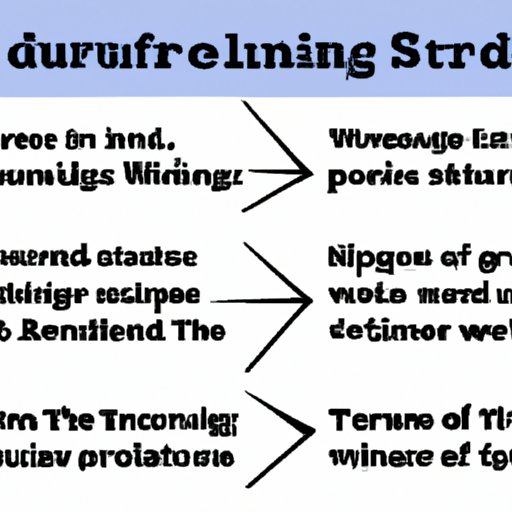Introduction
The structure of a piece of writing is just as important as the content itself. Without a solid structure, the writing can be difficult to understand and follow. It’s essential to have a well-thought out structure that guides readers through the information you’re trying to convey. In this article, we’ll explore some key methods to improve structure in writing so that you can create a clear and engaging document.
Definition of Writing Structure
Writing structure refers to the way that the sentences and paragraphs are organized within a piece of writing. A strong structure helps to keep the reader focused and guide them through the information. It should include an introduction, body paragraphs, and conclusion. The body should have several paragraphs that each focus on a different point, with clear transitions between each topic.
Purpose of the Article
The purpose of this article is to provide tips and strategies for improving the structure of your writing. We’ll discuss how to utilize an outline to plan your writing, make sure every paragraph focuses on one main point, use transitions to connect ideas, check for clarity and consistency, vary sentence structure, and read aloud and edit as necessary.
Utilize an Outline to Plan Your Writing
Creating an outline before you begin writing can help you stay organized and ensure that you cover all the points you want to make. An outline is a roadmap of your writing project and it can help you stay focused and on track. It’s also helpful in identifying any gaps in your argument or any areas where more research or explanation is needed.
Benefits of Using an Outline
Using an outline can save time and energy when writing. It allows you to organize your thoughts, plan out your arguments, and get feedback from peers or mentors. It also helps you identify any weak points in your writing and gives you an opportunity to address them before you start writing. With an outline, you can easily move sections around if you need to, which can help you refine your structure.
Steps for Creating an Outline
Creating an outline is simple and only takes a few steps. First, think about your main topic and what points you want to make. Write down these points and add additional details and research to support them. Next, arrange the points in order of importance, making sure that each point logically follows the previous one. Finally, review your outline to make sure that it covers all of the relevant points and that the structure is clear and easy to follow.

Make Sure Every Paragraph Focuses on One Main Point
When writing, it’s important to make sure that each paragraph has a single focus. This will help keep your writing clear and organized. It’s also important to make sure that the topic of each paragraph is related to the overall theme of the essay or article.
Benefits of Using a Single Focus
Using a single focus for each paragraph makes your writing easier to read and understand. It also helps you to stay on track and avoid rambling. By having a focused point for each paragraph, you can ensure that your writing stays on message and that each paragraph ties back to your overall argument.
Examples of Good Paragraph Structure
A good paragraph structure should include a topic sentence at the beginning of the paragraph, followed by supporting evidence and examples. Each sentence should be related to the topic sentence and should build on the argument. Finally, the paragraph should end with a concluding sentence that summarizes the main point. Additionally, the sentences within the paragraph should be logically ordered and connected with transitions.
Use Transitions to Connect Ideas
Transitions are words or phrases that connect one idea to another. They help the reader follow your train of thought and understand the connections between ideas. Transition words can also help to emphasize a point or signal a shift in direction.
Definition of Transitions
Transitions are words or phrases that link one idea to another. Common transition words include “however,” “therefore,” “in addition,” “as a result,” and “for example.” Transitions can also be phrases such as “on the other hand” or “in contrast.”
Examples of Effective Transitions
Here are some examples of effective transitions: “On the other hand,” “In addition,” “Furthermore,” “Moreover,” “Nevertheless,” “Consequently,” “Hence,” “Therefore,” “Thus,” “For instance,” and “For example.”

Check for Clarity and Consistency
Once you’ve finished writing, it’s important to go back and check for clarity and consistency. Make sure that your writing is clear and easy to understand. Look for any errors in grammar or spelling, as well as any awkward phrasing or awkward transitions. Additionally, make sure that all of your facts are accurate and that your writing is consistent throughout.
Tips for Checking Clarity
To check for clarity, read your writing out loud. This will help you identify any awkward phrasing or unclear sentences. Additionally, ask someone else to read it and provide feedback. This can help you spot any errors or awkward phrasing that you might have missed.
Ways to Ensure Consistency
To ensure consistency, review your writing for any inconsistencies in tone, style, or argument. Make sure that all of your facts are accurate and that you’re using the same terminology throughout. Additionally, pay attention to the transitions between paragraphs and make sure that they’re logical and easy to follow.
Vary Sentence Structure
Varying your sentence structure can help make your writing more interesting and engaging. Instead of using the same sentence structure over and over again, try mixing up the length and structure of your sentences. This will keep your readers engaged and make your writing more enjoyable to read.
Benefits of Varying Sentences
Varying your sentence structure adds interest and variety to your writing. Short sentences can be used to emphasize a point or draw the reader’s attention, while longer sentences can help to explain or elaborate on a point. Additionally, varying your sentence structure can help make your writing flow better and make it easier to read.
Examples of Different Sentence Structures
Here are some examples of different sentence structures: simple sentences (subject + verb), compound sentences (two simple sentences joined by a conjunction), complex sentences (one independent clause and one dependent clause), and compound-complex sentences (multiple independent and dependent clauses). Additionally, you can vary the length of your sentences to add further interest.

Read Aloud and Edit as Necessary
Once you’ve written your piece, it’s important to read it aloud and edit as necessary. Reading aloud can help you spot any errors or awkward phrasing that you may have missed. Additionally, it can help you identify any areas where your writing could be improved or clarified.
How Reading Aloud Helps with Editing
Reading aloud can help you identify any mistakes or awkward phrasing in your writing. It also helps you identify any areas where your writing could be improved or clarified. Additionally, reading aloud can help you identify any areas where your structure could be improved, such as transitions between paragraphs or points.
Tips for Effective Editing
When editing, take a step back and look at your writing objectively. Read your work out loud and pay attention to any awkward phrasing or errors. Additionally, ask someone else to read it and provide feedback. Finally, make sure that all of your facts are accurate and that your writing is consistent throughout.
Conclusion
Improving the structure of your writing can help make your writing clearer and easier to understand. Utilizing an outline to plan your writing, making sure each paragraph focuses on one main point, using transitions to connect ideas, checking for clarity and consistency, varying sentence structure, and reading aloud and editing as necessary can all help you improve the structure of your writing.
Summary of Key Points
In summary, here are some key points to remember when trying to improve the structure of your writing: utilize an outline to plan your writing, make sure each paragraph focuses on one main point, use transitions to connect ideas, check for clarity and consistency, vary sentence structure, and read aloud and edit as necessary.
Final Thoughts
Having a strong writing structure is essential for creating a clear and engaging document. By following the tips and strategies outlined in this article, you can improve the structure of your writing and ensure that your readers have a positive experience.
(Note: Is this article not meeting your expectations? Do you have knowledge or insights to share? Unlock new opportunities and expand your reach by joining our authors team. Click Registration to join us and share your expertise with our readers.)
